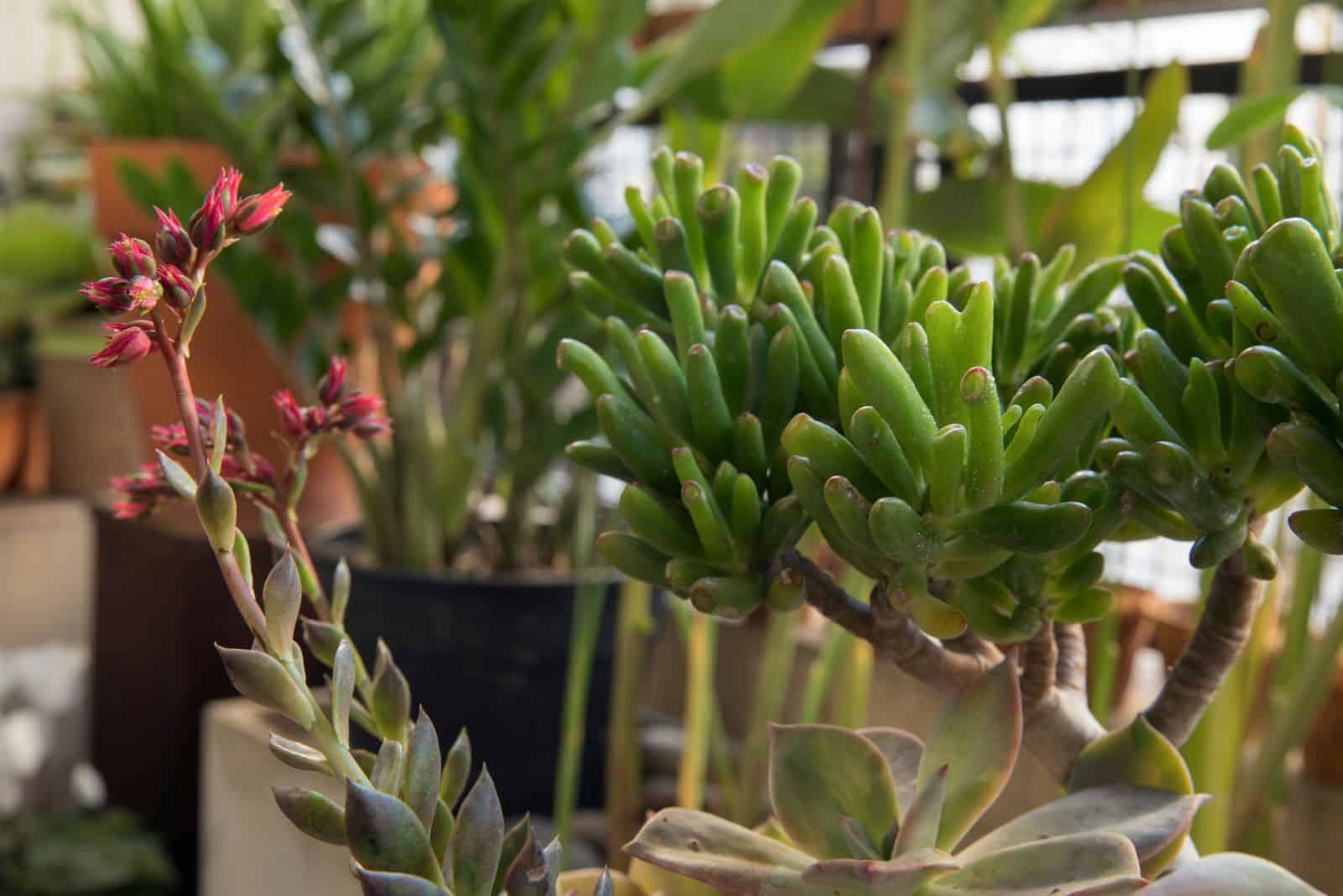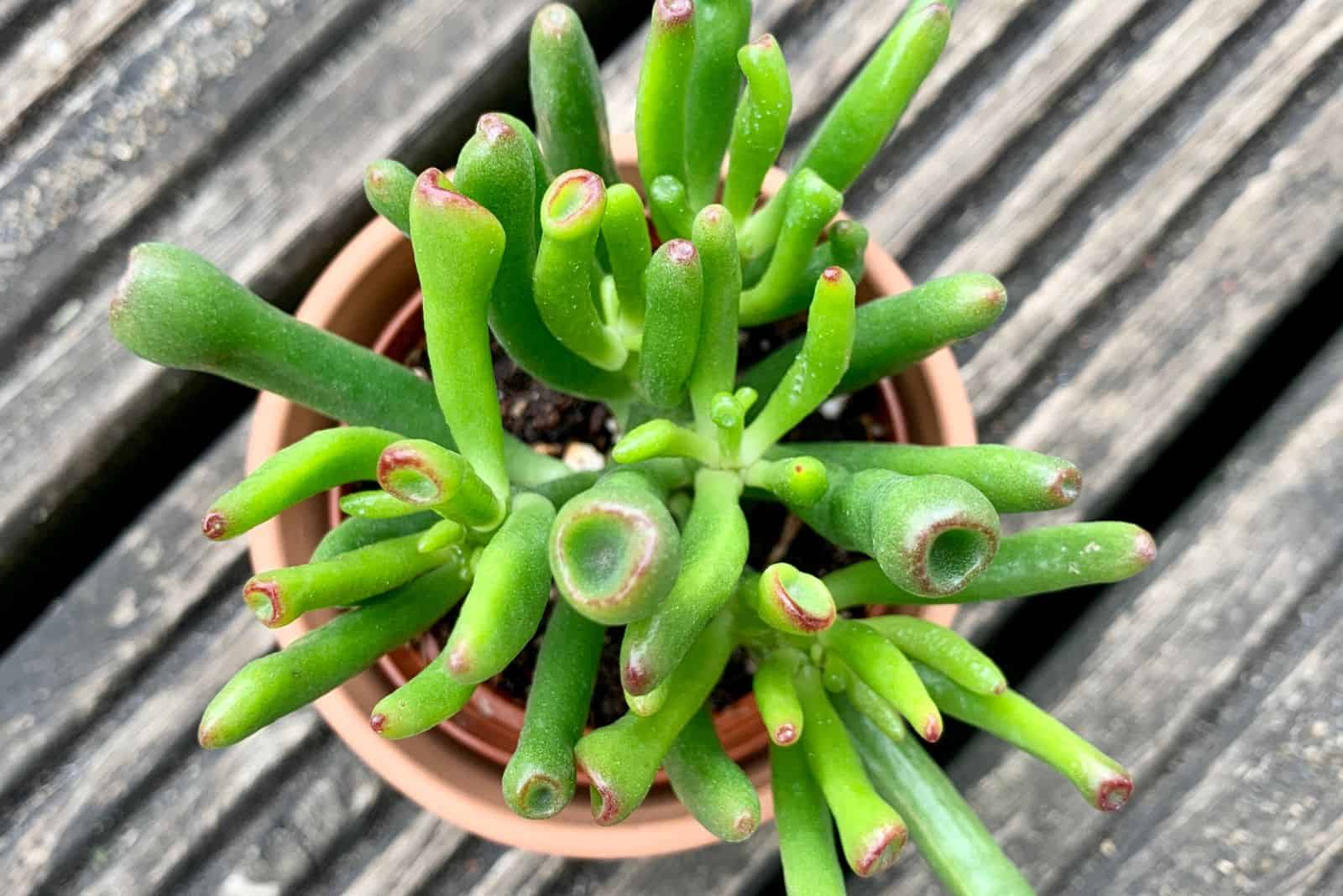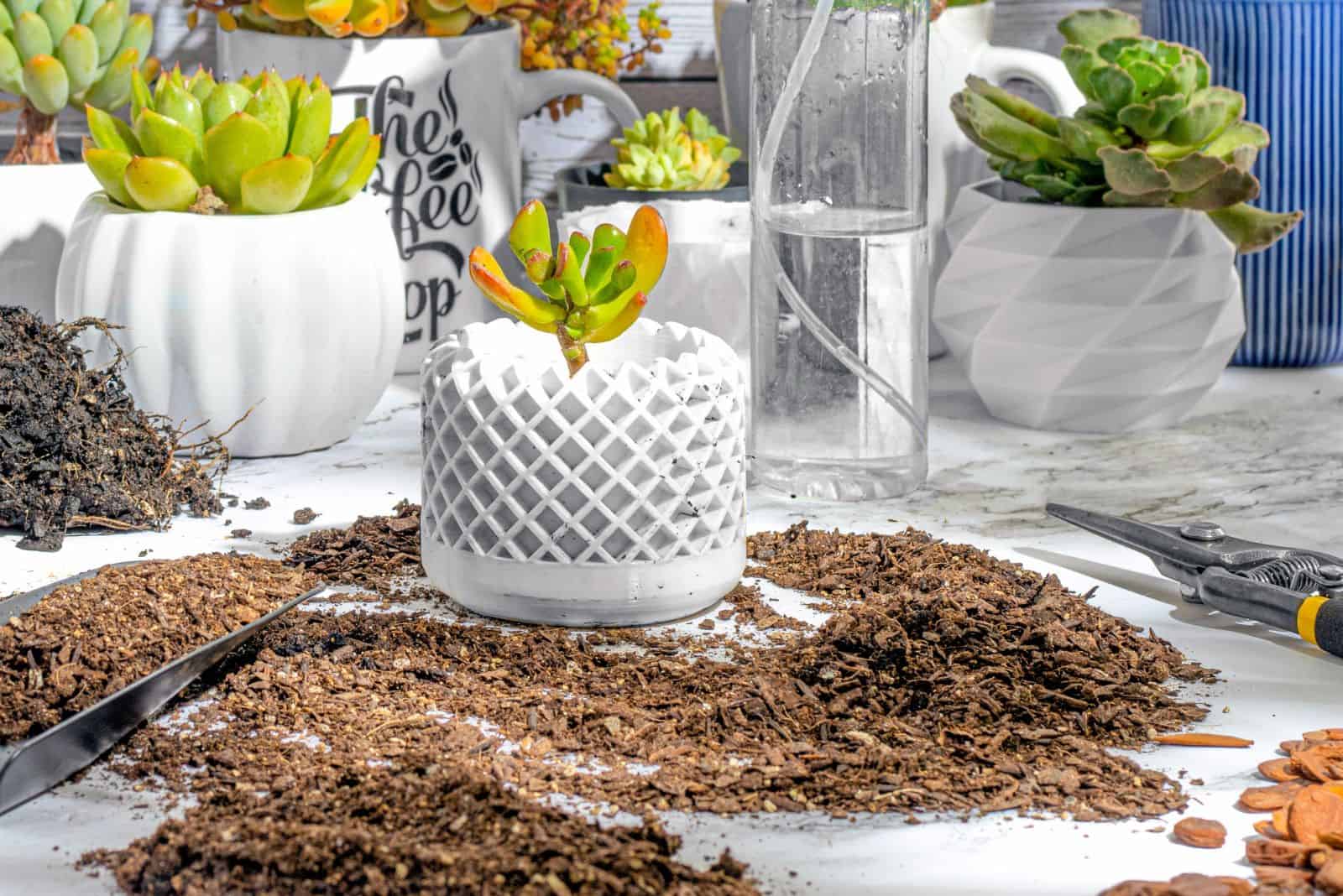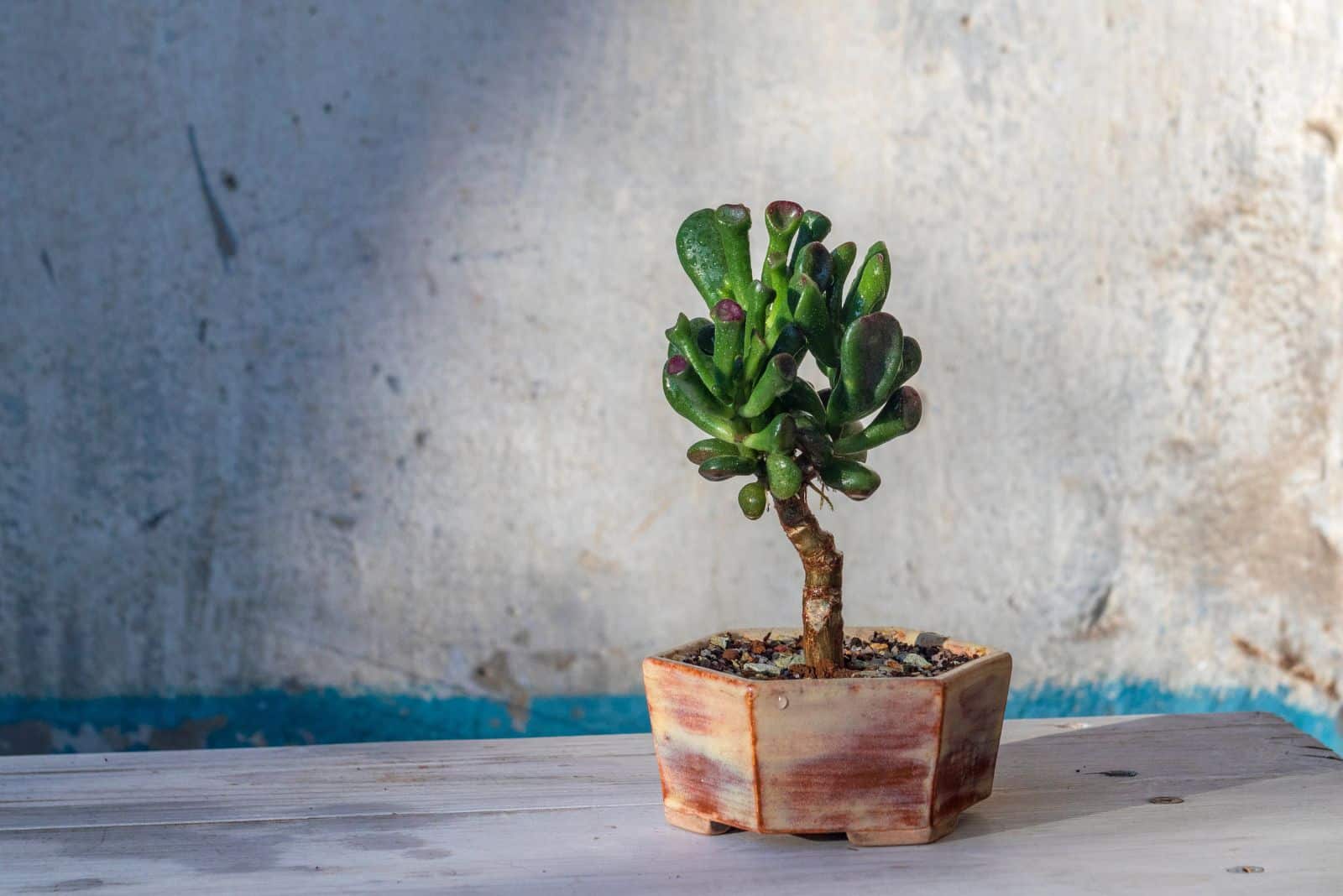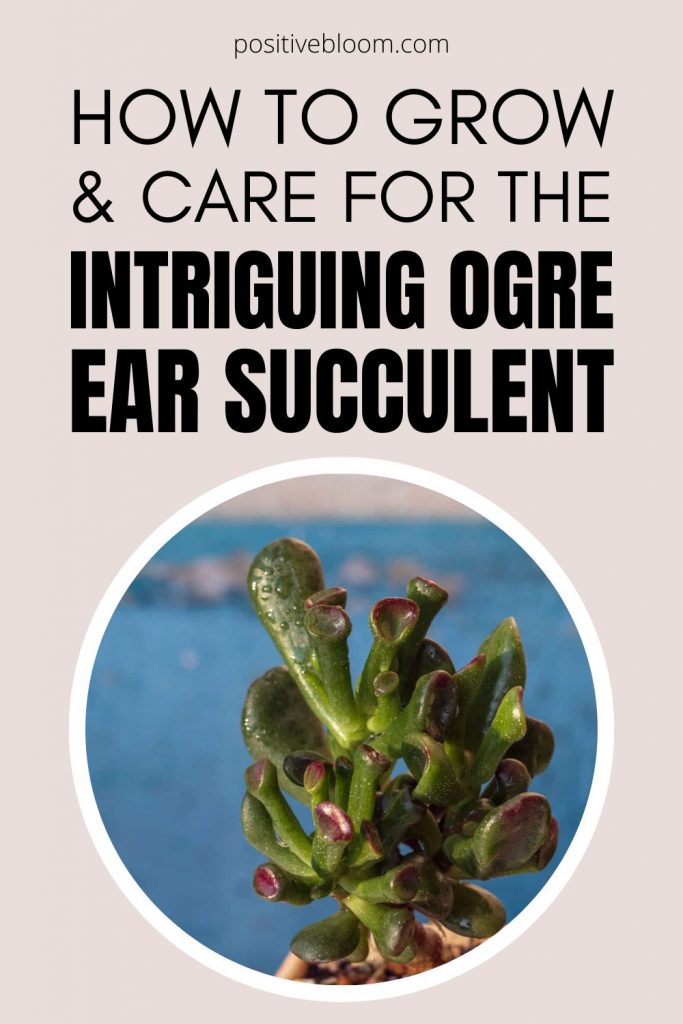Plants are often named after botanists or some specific feature of their leaves, but there’s one plant that, I dare say, has the most interesting name ever!
The Ogre ear succulent has the root words ogre and ear. If you have watched the movie or read the story of Shrek, you know what an ogre is.
Many think of ogres as somewhat ugly and scary creatures, but personality matters when it comes to this character. The Ogre ear houseplant is also called Shrek’s ears, and is far from ugly.
It comes under many other interesting nicknames, so keep reading to find out more. I’m also going to show you how to care for this unique plant and propagate it.
Before I move on, here’s some basic info about this succulent:
[table id=463 /]
Let’s get started!
What Is An Ogre Ear Succulent?
I’m sure you have heard of JRR Tolkien and the incredible fantasy novel, The Lord of the Rings. Wizards and hobbits are part of this masterpiece; Gollum is a deformed hobbit, and Crassula ovata Gollum jade can be considered a malformed relative of another famous Crassula plant known as Crassula ovata jade plant.
Don’t confuse Gollum jade with Hobbit jade; although the names are used interchangeably, they are entirely different plants.
The leaves of this Crassula plant are tubular and elongated. They have a puckered end that resembles a suction cup; pretty odd, don’t you think? The leaves are green and have red tips.
This Crassula cultivar produces star-shaped flowers that come in pink or white.
The Gollum jade grows up to 23 inches in height and 30 inches in width when grown indoors. This compact herbaceous succulent grows well even with a bit of neglect.
The Crassula ovata ‘ET’s Fingers’ Variegated Jade is a Crassula ovata species that features orange tinges and red tips. Many confuse it with the Ogre Ear, but they are different plants.
You can grow a Crassula ovata Gollum as an ornamental plant indoors, where it looks impressive if combined with Aloe, Senecio, and Haworthia plants.
How To Care For The Ogre ear Succulent aka Crassula Ovata Gollum Jade
The Ogre ear plant has pretty low care requirements. It thrives in full sun to partial shade, moderate temperatures, well-draining soil, and occasional fertilizing.
Let’s get into details!
How Much Sun Does An Ogre Ear Succulent Need?
The Shrek’s ear plant thrives in locations with lots of bright indirect light. Although it can endure full sun, it must first acclimate to it so as to avoid burning.
More light exposure causes the plant to turn lime-green, maintaining a richer green color when kept in partial shade. With increased sunlight exposure, the reddish tinge on the tips becomes more noticeable.
If you plan to grow this Crassula as an outdoor plant, gradually increase the amount of sunlight before taking it outside.
These succulents love direct sunlight, but only in the mornings. If you expose it to strong afternoon sun, the leaves may get burned.
When grown indoors, your Gollum jade benefits from filtered sunlight, so placing sheer curtains on south-facing windows is the best you can do.
When growing this plant outdoors, put it near taller plants to create a little bit of shade.
Temperature & Humidity Requirements
This Crassula plant is hardy in USDA growing zones 9 and 10. The Finger plant can withstand brief periods of mild frost.
Growers who live in colder climates should cultivate these plants in pots. This will give you enough time to take it indoors before the first expected frost.
You can encourage your Finger plant to bloom by paying attention to nighttime temperatures. If you grow this plant outdoors, make sure the temperatures aren’t lower than 50 degrees Fahrenheit.
If you keep it indoors, nighttime temperatures of about 60 degrees Fahrenheit will suffice.
This is a common feature of all succulents; the nighttime temperatures in their native habitat are lower, and mimicking the temperature range plays a crucial role in the plant’s development in a controlled setting.
Many growers wonder if succulents love humidity. The Crassula ovata Gollum is one of the succulents that enjoys humidity.
It can sustain a humidity level of about 50%, and you don’t need to water it as frequently thanks to this feature, which makes maintenance easier.
The Best Potting Mix
Crassula plants won’t forgive you if you let their soil get soggy, so you must ensure well-draining soil.
You can go with a ready cactus soil mix and supplement it with perlite for additional drainage. A ratio of 2:1 will suffice.
You can also go with sandy soils by mixing standard potting soil and sand for gardening.
If you decide to grow a Gollum jade as a bonsai, I recommend using ready soil mixes available on Amazon and Etsy.
How Often Should I water An Ogre Ear Succulent?
Your local climate has a big impact on how much water you need. Although succulent plants are well adapted to dry weather, they also perform well when given enough water. The only thing to pay attention to is the moisture content in the soil; overly wet soil can kill your Shrek’s ear plant.
There isn’t really a defined timetable or method for watering succulents.
For example, if you live in an extremely dry environment, you’ll need to water your Gollum jade every week during the growing season. As far as the spring and fall are concerned, you can reduce watering to once every two weeks.
If you live in a rainy area, you don’t need to water frequently. Too much water in the soil may damage the delicate roots of your Ogre ear.
If you grow these plants indoors, you might not need to water them frequently, particularly if they don’t get a lot of light. For Crassula plants, an excess of water and insufficient light is a formula for catastrophe.
Checking the soil’s moisture content is an excellent approach to determining when to water. If the soil dries out an inch below the soil surface, proceed with watering. If unsure, it’s better to leave your plant to dry out rather than overwater it.
Check the plant’s overall appearance so you can alter the amount of water it receives.
When And How To Fertilize The Shrek’s Ears Plant
These Crassula plants don’t require fertilization, but it may encourage them to flower.
These plants spend a lot of energy in flower production; therefore, they’ll benefit from more nutrients during the blooming season.
The best time to fertilize Ogre ear plants is during the active growth season, which is in the spring and summer.
It would be best to dilute the fertilizer to half strength and apply it every 14 days. You can use balanced fertilizers or ones explicitly designed for succulents and cacti.
Repotting
If you grow your Finger plant in a pot, you don’t need to worry too much about repotting. They’ll grow just fine if kept in the same soil for years.
This is another great feature of these succulents, which makes them perfect plants even for beginners.
It would be best if you always repotted in early spring before your plant displays new growth. Cut back on fertilizing after repotting and reduce watering until your plant recovers from transplant shock.
Growing The Gollum Plant As A Bonsai
Many beginner bonsai growers decide on the Gollum jade plant as it’s easy to maintain.
You can easily train these plants to get the desired shape. It won’t cause much trouble when wiring and will adapt to new shapes quickly.
If you want new branches from the bottom, just snip new shoots. The best idea would be to prune during the growing season, i.e., spring and summer.
2 new trunks will typically develop from every cut area.
You can also grow this Crassula plant in clumps of rosettes.
How To Propagate The Ogre Ear Succulent Plant
Propagation is my favorite part of plant cultivation. You can either propagate your Gollum jade through stem or leaf cuttings.
Both ways will give you a new plant. Still, I highly recommend propagating through stem cuttings, especially if you are a beginner.
If using leaf cuttings, I recommend taking a few leaves as there’s a little possibility they’ll all root.
Let’s look at both ways!
Stem Cuttings
1. Inspect your plant and search for a healthy stem. Take a stem cutting and leave it to callous over for a day or two.
2. Apply rooting hormone to the cut end; this is not obligatory, but may promote faster root development.
3. Fill a pot that has drainage holes with a suitable potting mix for Crassula plants. Make a tiny hole in the soil center and put the Shrek’s ear in it.
4. Put the pot with the cutting in a spot where it will receive enough light; make sure intense sun rays don’t reach the cutting. Mist the soil every few days.
5. New roots will develop in about two weeks and will fully establish in a month.
6. Reduce misting after the root system is fully developed, and proceed with standard watering. Increase sunlight exposure as the plant develops.
Leaf Cuttings
1. Carefully remove a leaf (leaves), including the base. You can twist it a little bit, but don’t use force. Make sure the leaf you remove isn’t diseased, damaged, or discolored.
2. Apply rooting hormone to the cut end; this is not obligatory, but may promote faster root development.
3. Allow the roots to dry out for a day or two. Never leave them exposed to direct sun to ‘promote drying’. This will destroy every possibility of rooting, and the cutting will most likely die.
4. Fill a pot that has drainage holes with a suitable potting mix for the Ogre ear plant. Remember, it needs to drain well to avoid water accumulation.
5. Lay the leaf (leaves) on the potting mix, and gently press the cut end in the soil.
6. It may take months for the cutting to establish a robust root system. This technique is a bit more complicated and lasts longer than the stem cutting method. Once your new Gollum jade plant is fully established, proceed with the usual care.
Gollum Jade: Common Issues
Plants from the Crassula genus are really easy to maintain, and the fact they are generally considered problem-free makes things even better.
The essential thing to pay attention to is watering; the way you water your Crassula ovata Gollum will determine its further development.
Let’s look at all the possible issues you may encounter.
Pests
This Crassula plant most likely won’t have issues with pests when grown indoors. Be careful if moving it from outdoors because some nasty mealybugs and spider mites may be hidden on the tubular leaves.
If you notice any of these tiny creatures, you can rub the leaves with neem oil or apply an insecticidal soap solution. Infestations are rare, but if they occur, use pesticides.
Black Spots
Remember that Crassula plants are sensitive to overwatering, and their roots can easily rot if there’s too much water in the soil.
One of the most common signs of rotting is black spots on the green leaves.
If you grow your Gollum plant outdoors and live in a rainy area, this problem frequently occurs.
The best idea would be to remove the leaves with black spots, just make sure you use sanitized shears, knives, or pruners.
Leave the plant to dry out sufficiently and delay watering for some time.
If you are growing it outdoors, consider finding a new place for the plant.
Leaves Wilting, Shriveling, And Falling Off
Although overwatering causes damage to Crassula plants, don’t leave the plants without water for too long either!
If you notice that the leaves are wilting, shriveling, and falling off, you need to check the soil moisture content. If the soil is entirely dry, water your plant more frequently until it recovers.
Pay attention to other conditions, such as humidity, light, and temperature. High humidity, too much light, and warmer temperatures change the watering needs of this Crassula plant.
Although Crassulas are easy to maintain, they won’t grow if completely forgotten (who would?!).
FAQs
Is the Ogre ear succulent toxic?
Yes, the Ogre ear or Crassula ovata Gollum is a mildly toxic plant. It may cause different issues after ingestion, such as loss of appetite, diarrhea, or swelling. Please keep your Shrek’s ear plant somewhere curious children, dogs, and cats can’t reach it.
What is the difference between an ogre ear succulent and a jade plant?
The Ogre ear succulent is a species of Crassula ovata, commonly referred to as the Jade plant. It features tubular leaves with red tips, distinguishing it from the standard Jade plant. Both succulents have the same care requirements. If you provide more light to the Gollum plant, the red color on the tips will be more noticeable.
Wrapping Up
When you combine plants and literature, you know something great will happen!
The Ogre ear succulent is an excellent plant to grow both indoors and outdoors. It has a little bit of an odd shape, which is why it got such a name, but in my opinion, that makes the plant even more interesting.
If you love epic books like The Lord of the Rings and Shrek, I’m sure you’ll enjoy growing a Shrek’s ear plant.
Additionally, if you are looking for a low-maintenance plant that will forgive you if you forget it for a while, this succulent is perfect for you. The more care you put into it, the better it will thrive!
Until next time!
Like this post? Share or pin it for later!

